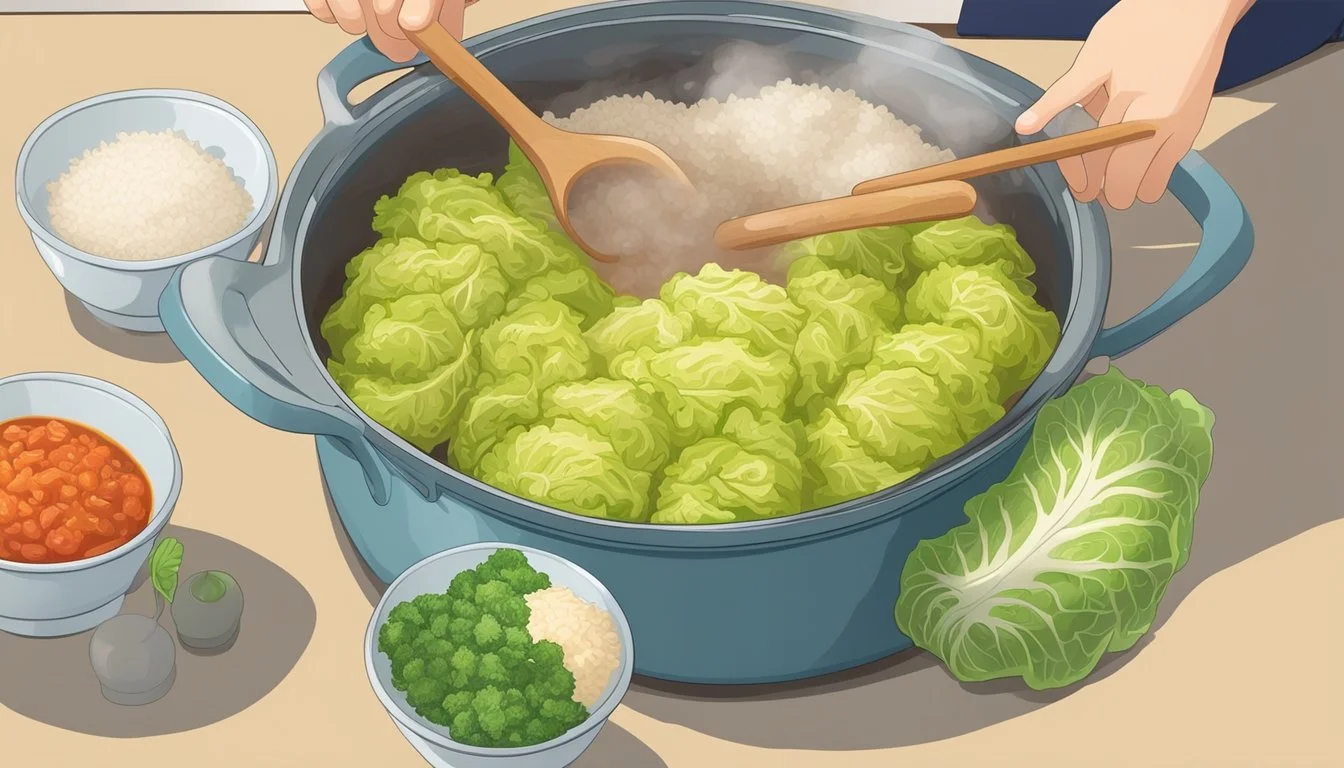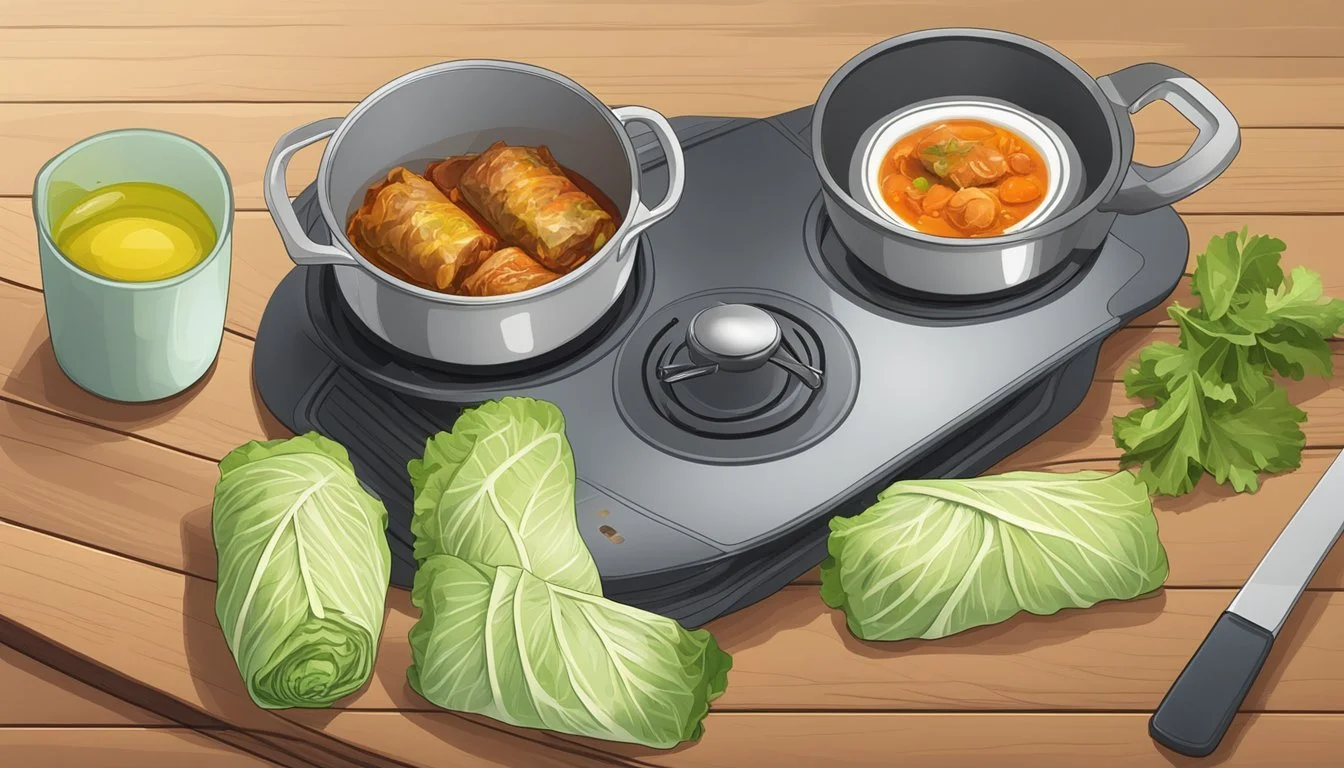How to Reheat Gluten-Free Stuffed Cabbage Rolls
Easy and Effective Methods
Reheating gluten-free stuffed cabbage rolls can be a straightforward process that preserves the texture and flavor of this healthy dish. Using simple ingredients, you can ensure that your cabbage rolls stay moist and delicious. The best way to reheat your gluten-free stuffed cabbage rolls is in the oven at 350°F for 30-45 minutes, covered with aluminum foil to retain moisture.
The oven isn't your only option. For a quicker method, the stovetop can be effective. Place the cabbage rolls in a saucepan with a small amount of water or tomato sauce, cover, and heat over low to medium heat for 10-15 minutes. This method helps maintain the integrity of the ingredients while reheating evenly.
Reheating your gluten-free stuffed cabbage rolls properly not only enhances the flavors but also ensures they remain a healthy and satisfying meal option. Whether you choose the oven or stovetop, following these tips will help you enjoy your cabbage rolls just as much as when they were freshly made.
Understanding Gluten-Free Stuffed Cabbage Rolls
Gluten-free stuffed cabbage rolls combine the delectable taste of traditional cabbage rolls with the dietary necessities of a gluten-free meal. Key points include the nature of gluten-free diets, the essentials of making cabbage rolls, and the nutritional benefits.
Defining Gluten-Free
Gluten is a protein found in wheat, barley, and rye. For those with celiac disease or gluten intolerance, consuming gluten can cause serious health issues. A gluten-free diet excludes these grains and any products made from them to prevent adverse reactions.
Gluten-free alternatives include rice, quinoa, and corn. When preparing gluten-free stuffed cabbage rolls, ensuring all ingredients, such as sauces and fillers, do not contain hidden gluten is essential.
The Basics of Cabbage Rolls
Cabbage rolls are a classic dish made from cabbage leaves wrapped around various fillings, like ground meat, rice, and spices. Traditional recipes often include bread crumbs or flour-based thickeners, which need substitution in gluten-free versions.
Ingredients typically include cabbage, ground meat (often beef or pork), rice or gluten-free grains, and a rich tomato sauce. The rolls are usually baked to merge flavors and ensure the rolls are heated thoroughly. To keep rolls moist and flavorful, covering with aluminum foil during baking is advisable.
Health Benefits and Nutritional Profile
Stuffed cabbage rolls are not only tasty but also offer several health benefits. Cabbage itself is rich in vitamins C and K, fiber, and various antioxidants. Using lean ground meat adds protein, while rice or other gluten-free grains contribute to the fiber and carbohydrate content.
A single serving of stuffed cabbage rolls can be a part of a healthy dinner recipe, fitting well into clean eating because of the whole food ingredients. Nutritionally, these rolls provide a balanced mix of proteins, vitamins, and minerals, beneficial for overall health and wellness. Avoiding gluten helps to reduce inflammation and digestive issues for those with gluten sensitivity.
Ingredients and Preparations
Making gluten-free stuffed cabbage rolls requires careful selection of ingredients and precise preparation steps. Key areas to focus on involve the stuffing ingredients, preparing the cabbage, and crafting a gluten-free filling.
Selecting Ingredients for Stuffing
The core ingredients for gluten-free stuffed cabbage rolls typically include beef, cooked rice, and vegetables. Opt for lean ground beef to ensure a healthy balance. Use either white or wild rice for the filling.
Fresh onions, garlic, and carrots are vital for flavor. Mince the onion and garlic finely and grate the carrots.
Salt, pepper, and olive oil will enhance the taste. It's important to use gluten-free tomato sauce or make your own to coat the cabbage rolls.
Additionally, some might add sauerkraut for a tangy twist.
Preparing the Cabbage
First, choose a firm, fresh green cabbage.
Remove the outer leaves and core. Submerge the cabbage head in boiling water for 3-5 minutes.
This softens the leaves and makes them pliable for wrapping.
Carefully peel off the leaves, ensuring they remain whole.
Pat the leaves dry with a towel, as moisture can make them slippery during wrapping.
Making the Gluten-Free Filling
In a large bowl, combine the ground beef and cooked rice. The rice can be either white or wild rice, based on preference.
Add finely minced onion, garlic, and grated carrots to the mix.
Crack an egg into the bowl for binding the ingredients together.
Season with salt, pepper, and a drizzle of olive oil.
Mix thoroughly until all components are evenly distributed.
This filling will form the core of the cabbage rolls.
Lastly, prepare a gluten-free tomato sauce to coat the rolls before baking.
Cooking and Assembly
Making gluten-free stuffed cabbage rolls involves blanching the cabbage leaves, assembling the rolls with a savory filling, and a final baking step to infuse flavors and ensure everything is thoroughly cooked.
Blanching the Cabbage Leaves
Begin by preparing the cabbage leaves. Carefully remove whole leaves from a large cabbage. Use a sharp knife to cut around the core, making it easier to peel off the leaves without tearing them.
Bring a large pot of water to a boil. Submerge the cabbage leaves in boiling water for 2-3 minutes, or until softened but still sturdy enough to wrap. Quickly transfer the blanched leaves to a bowl of ice water to stop the cooking process and maintain their vibrant color. Pat the leaves dry with a clean kitchen towel.
Assembling the Cabbage Rolls
For the filling, combine ground meat (beef, chicken, or turkey) with rice or a gluten-free grain like quinoa. Mix in finely chopped onions, garlic, and your choice of spices for flavor. Ensure the mixture is well-seasoned.
To assemble, place a blanched cabbage leaf on a flat surface. Spoon a small amount of filling onto the leaf's base. Fold in the sides and roll from the base upward, tucking the ends to secure the filling. Repeat this process for all the leaves.
Arrange the stuffed cabbage rolls seam-side down in a baking dish. Prepare a sauce using tomato paste, water, and optionally, sugar-free sweetener. Pour the sauce over the rolls, ensuring they are evenly coated.
Final Baking
Preheat the oven to 350°F (175°C). Cover the baking dish with aluminum foil to retain moisture. Place it in the oven and bake for 30-45 minutes, checking occasionally.
The cabbage rolls should be heated through, and the internal temperature should reach 165°F for safety. If needed, bake longer and check every 5 minutes. The sauce will thicken, and the rolls will become tender.
For added flavor, offer extra sauce on the side and enjoy your gluten-free stuffed cabbage rolls hot from the oven.
Proper Storage Techniques
Proper storage is key to maintaining the flavor and texture of gluten-free stuffed cabbage rolls. Techniques vary depending on short-term and long-term needs, each with its methods and best practices.
Refrigerating Your Cabbage Rolls
To store cabbage rolls in the refrigerator, ensure they are completely cooled before transferring them. Place the rolls in an airtight container to prevent moisture loss and contamination. If layering is necessary, separate the layers using parchment paper.
Shelf Life: Refrigerated cabbage rolls are best consumed within 3-4 days.
Additional Tips: Applying a thin coat of tomato sauce helps in keeping them moist. Ensure the refrigerator maintains a temperature of 40°F (4°C) or lower to inhibit bacterial growth.
Freezing for Long-Term Storage
For extended keeping, freezing is the most effective method. First, allow the cabbage rolls to cool. Individually wrap each roll in plastic wrap and then wrap a layer of aluminum foil around the plastic wrap for added protection against freezer burn.
Label and Date: Writing the date on the foil aids in tracking storage time.
Storage Life: Thaw and consume within 1-2 months for optimal quality.
Freezer-Friendly Containers: Opt for containers labeled "freezer-friendly" to avoid cracking or damage. This step ensures you maintain peak freshness and taste.
Best Practices for Reheating
To reheat gluten-free stuffed cabbage rolls, maintaining their tender texture and flavor is essential. Two highly effective methods are using the oven and the stovetop.
Oven Reheating Method
Preheat the oven to 350°F (175°C). Arrange the cabbage rolls in an oven-safe dish. Applying a thin layer of tomato sauce over the rolls can help retain moisture and enhance taste.
Cover the dish with aluminum foil to prevent the rolls from drying out. Place the dish in the oven and allow it to heat for 30-45 minutes. Ensure the internal temperature reaches 165°F (74°C) for safety, especially if they contain ground meat. Using a meat thermometer can be very helpful here.
To avoid sticking, lightly coat the dish with cooking spray or butter before placing the cabbage rolls. Check periodically to ensure the rolls remain moist and tender. This method provides an even reheating process, preserving the flavors and textures.
Stovetop Reheating Method
Place the cabbage rolls in a saucepan with a small amount of water or more tomato sauce for added moisture. This method is faster but requires careful temperature control to avoid scorching.
Cover the pan and heat on low to medium settings. Stir occasionally and check the rolls, ensuring they are evenly reheated. The process should take about 10-15 minutes.
Choosing the right cookware, such as a heavy-bottomed pan, helps distribute heat evenly, preventing burning. Maintaining a low to medium temperature ensures the cabbage stays tender and moist. Periodically, turn the rolls to avoid sticking at the bottom of the pan, giving a consistent reheating result.
Serving and Pairing Ideas
Gluten-free stuffed cabbage rolls can be enhanced with various side dishes to create a well-rounded and satisfying meal. Here are some side dishes to consider that complement the flavors of stuffed cabbage rolls.
Complementary Side Dishes
Mashed Potatoes: Creamy mashed potatoes serve as an excellent companion to stuffed cabbage rolls. Their smooth texture and mild flavor balance the rich and savory notes of the dish.
Sauerkraut: Sauerkraut's tanginess contrasts nicely with the stuffed cabbage rolls, adding a refreshing bite. Its acidity helps to cut through the richness of the rolls, providing a well-rounded meal.
Sour Cream: A dollop of sour cream can enhance the flavor of cabbage rolls. It offers a creamy and tangy element that pairs well with tomato-based sauces commonly used in stuffed cabbage.
Vegetable Sides: Steamed or roasted vegetables like carrots, green beans, or Brussels sprouts add color and nutrition. These vegetables provide a lighter counterpart to the heavier main dish.
Mushroom Sauce: A homemade mushroom sauce can elevate the stuffed cabbage rolls. The earthy flavor of mushrooms complements the hearty filling, adding depth to each bite.
Tomato Sauce: Reheating the rolls with extra tomato sauce can help keep them moist and flavorful. The acidity of the tomato benefits the overall taste profile, making each mouthful more appetizing.
Special Variations
Exploring different twists on gluten-free stuffed cabbage rolls allows for accommodating diverse dietary preferences and cultural inspirations. From creating vegan and vegetarian options to tapping into traditional variations across regions, there's ample room for delicious creativity.
Creating Vegan and Vegetarian Options
Vegan and vegetarian versions of stuffed cabbage rolls can be made by replacing meat with ingredients like lentils, chickpeas, and quinoa. Lentils and chickpeas provide a hearty texture similar to ground pork, offering a satisfying alternative. Quinoa adds a protein boost, making the rolls not only filling but also nutritionally balanced.
Adding a mix of mushrooms, bell peppers, and spinach enhances the rolls' flavor profile, while maintaining their moisture. Nutritional yeast can contribute a cheesy flavor, helping replicate the umami taste generally provided by meat.
In vegan versions, using bread crumbs made from gluten-free bread and binding ingredients like flax eggs can help maintain the structure. Don't forget the importance of seasoning with herbs like dill, parsley, and paprika to elevate the taste.
Cultural Variations
Stuffed cabbage rolls appear in various forms worldwide, each unique in flavor and preparation. The Polish version, known as golumpki or gołąbki, traditionally uses ground pork but can be adapted with mushrooms and rice for a gluten-free twist.
In Ukrainian cuisine, holubtsi may incorporate buckwheat instead of rice, providing a nutty taste and gluten-free assurance. Greek variations, using vine leaves, feature ingredients like rice, pine nuts, and currants, diverging from the typical cabbage wrapping.
In Germany, stuffed cabbage might include a mix of beef and pork, but quinoa and vegetables work well as gluten-free substitutes. Sarmale, a Romanian variant, typically combines meat and rice, easily converted to gluten-free by using millet or cornmeal.
Exploring these cultural variations not only respects traditional flavors but also innovates with gluten-free adaptations, making the dish accessible to everyone.
Final Tips and Tricks
When reheating gluten-free stuffed cabbage rolls, preheating the oven is crucial. Set it to 350°F (175°C) for best results. This ensures even cooking and prevents texture issues.
Covering the baking dish with aluminum foil helps retain moisture. Keeping the rolls from drying out while reheating will enhance their flavor profile.
For those concerned with acid levels, adding a bit of extra tomato sauce can balance flavors without overcooking the rolls. This adds moisture and complements the cabbage’s texture.
Use a meat thermometer to check the internal temperature. Aiming for 165°F ensures the rolls are heated thoroughly without compromising health standards.
Planning to include stuffed cabbage rolls in your meal prep? They reheat well if stored properly. Arranging them in airtight containers helps maintain freshness and prevents freezer burn.
Reheating should take about 20-45 minutes depending on the portion size. Smaller portions heat faster and avoid uneven heating.
Consider a quick review of your reheating process if outcomes are less than perfect. Small adjustments can greatly improve the experience.
For an easy recipe approach, microwave reheating works but may affect texture. Oven methods are generally preferred for maintaining quality.
Making healthy food choices involves attention to details, and stuffed cabbage rolls can be a satisfying and nutritious option when reheated properly.
By following these tips, enjoy the delicious flavors of gluten-free stuffed cabbage rolls anytime.






